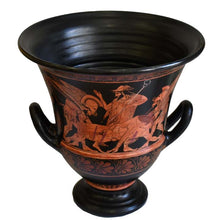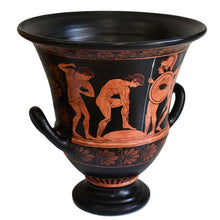The original item is located in Metropolitan Museum of Art in New York The Euphronios krater (or Sarpedon krater) is an ancient Greek terra cotta krater, a bowl used for mixing wine with water. Created around the year 515 BC, it is the only complete example of the surviving 27 vases painted by the renowned Euphronios and is considered one of the finest Greek vase artifactsin existence. The krater is decorated with two scenes. An episode from the Trojan War is shown on the obverse, this illustration depicts the death of Sarpedon, son of Zeus and Laodamia. The reverse of the krater shows a contemporary scene of Athenian youths from the 6th century BC arming themselves before battle. In the scene of Sarpedon's death, the god Hermes directs the personifications of Sleep (Hypnos) and Death (Thanatos) to carry the fallen away to his homeland for burial. While the subject of Sarpedon's death might normally be depicted as a stylized tableau, the figures in this scene are painted in naturalistic poses and with schematic but accurate anatomy. This style is emblematic of the Pioneer Group of late Archaic painters, of whom Euphronios is considered the most accomplished. The scene of the anonymous Greek youths on the reverse shares this naturalistic style, using all the Pioneer Group's characteristic techniques of anatomical accuracy, natural poses, foreshortening, and spatial illusion. Also characteristic of the Pioneer Group is the narrative tension created both by pairing these two scenes on the same piece, and by painting them in a common style. The death of Sarpedon, a quasi-mythological story which would be familiar to anyone viewing the krater, is an episode involving specific historical and mythological figures. The other scene, of the anonymous youths preparing for war, is both more general and explicitly contemporary. The young men are not heroes of legend; with their finely detailed features, they are given personality and character, but they could be any of the youthful soldiers in the Greek army. Both scenes are painted with similar styles, making the historical scene appear more contemporary; likewise, the contemporary scene begins to share some of the other's mythological qualities. The two scenes invite comparison between the narratives they depict; certainly, the hero Sarpedon was no less youthful than these anonymous boys, and Death and Sleep may well come for them as they did for him. The vase is signed both by Euxitheos as potter and Euphronios as painter. While it was customary for the painter to sign the finished work, it was less common for the potter to add his own name. The presence of both signatures indicates that Euxitheos felt the vase to be one of his finest works. Besides the artists' signatures on the obverse side, it also carries the inscription "Leagros is handsome." on the reverse. This inscription has allowed art historians to date the krater to approximately 520-510 BC, because at this time Leagros was considered the handsomest man in Greece. All names are written in Attic letters. The colors are very simple, natural pigments that could have easily been found in nature and utilized by the Ancient Greeks. It was Hand made in Greece, diameter size is approximately 10 inches. Our clay items are Hand made, Hand painted and not fastly made, nor are they cheaply made of substitute materials such as resin. We stick to the materials and methods used by ancient Greeks and use only top quality ceramics and paints. Do not expect "perfection" as if these clay vases was not mass produced from a machine like many are, but by hand.
Vase Details:
Condition: New, Handmade in Greece
Material: Clay
Diameter Size: 26cm (10")
Note that sizes may vary a little cause everything is Hand Made
********







